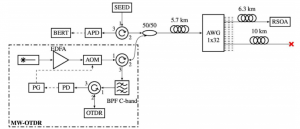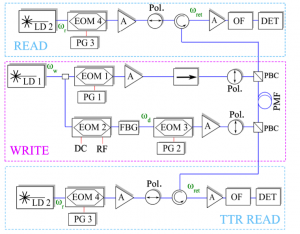OPTICAL FIBER COMMUNICATIONS
Spatial Division Multiplexing (SDM)
The steady increase of Internet traffic has fostered a growing interest about the exploitation of spatial diversity to broaden the transmission capacity of optical fiber links. A first solution consists in using fibers in the few-mode regime, such that each propagating mode can be used as an additional channel. Alternatively, multi-core fibers can be considered, in which several cores are densely packed in the cladding and each acts as a channel. Promising as they are, these approaches have to cope however with modal dispersion and random mode/core coupling, which cause deleterious distortion of the transmitted signal. In this respect, spatial division multiplexing is formally equivalent to polarization mode dispersion (PMD), a field in which PEG has a long-standing renowned experience.
The research activity carried out at PEG in the framework of spatial division multiplexing, consists of theoretical and experimental analyses of random mode coupling and methods to control it. An effort is being put in the accurate modelling of different sources of mode coupling, with the aim of providing a reliable theoretical framework to develop novel methods to taylor random mode-coupling. At the same time novel techniques to perform distributed characterization of few-mode fibers, based on the analysis of Rayleigh-backscattered light, are under development.
SDM in few-mode fibers
Raman amplification
This activity is dedicated to the development of optical amplifiers by exploiting Raman scattering in optical fibers. This phenomenon allows to transform any fiber into an optical amplifier by pumping it with a high power laser source. Raman amplifiers are particularly attractive for optical communications since they can be tuned at any wavelength, spanning over a ultra-broad band (several THz), with reduced noise figure. The theoretical investigations are related to enhance the amplifier gain by considering: novel fiber types, including micro-structured, photonic crystal fibers, hollow-core fibers doped by innovative materials, and spun fibers. Moreover theoretical and numerical investigations are dedicated to determine amplifiers characteristics by considering also gain saturation, pump depletion an cascaded amplification. The experimental characterization of Raman amplifiers is also considered; in this context gain measurement set-ups are being developed, including distributed gain detection by means of optical reflectometer.
The research activity carried out at PEG in the framework of spatial division multiplexing, consists of theoretical and experimental analyses of random mode coupling and methods to control it. An effort is being put in the accurate modelling of different sources of mode coupling, with the aim of providing a reliable theoretical framework to develop novel methods to taylor random mode-coupling. At the same time novel techniques to perform distributed characterization of few-mode fibers, based on the analysis of Rayleigh-backscattered light, are under development.

Passive optical networks
The new broadband access network is a strategic infrastructure for the sustainable development. There are different available technological solutions for Next Generation Access Network (NGAN) development which companies need to evaluate in making investment decisions and adopt the approach more in line with existing installations and market conditions. However, nowadays, Point to Multipoint (P2MP) architecture, implemented through Passive Optical Network (PON) systems, appears to be obtaining the favor of almost all the main European operators. PON systems present some advantages, such as the absence of electrical power supply in the primary and secondary links and the reduced operational costs; however, the bandwidth resources are shared among multiple users, which access the network in a centrally controlled fashion. The research activities in PONs address several sub-topics like: 1) PON monitoring through OTDR techniques; 2) modelling of RSOAs for their usage in colorless PONs; 3) modelling OFDM transmission in RSOAs based PONs.

Dynamic Brillouin gratings
Among all nonlinear optical phenomena, stimulated Brillouin scattering (SBS) is often overlooked, essentially because of its small natural bandwidth. Nonetheless, the relative low power needed to induce this effect makes SBS a very attractive effect for photonics. Recently the realization of dynamic Brillouin gratings (DBGs) in optical fibers [1,2] demonstrated to be an extremely versatile technique to achieve, with a single experimental setup, several all-optical signal processing functions: delay lines [3], all-optical time differentiation, time integration and true time reversal [4]. This research activity explore the additional potential applications of DBGs in all-optical processing. 1. Z. Zhu, D.J. Gauthier and R.W. Boyd, Science 318, 17481750 (2007); 2. K. Y. Song, W. Zou, Z. He, and K. Hotate, Optics Letters 33, 926-928 (2008). 3. L. Thevenaz, S. Chin, Laser & Photonics Reviews 6, 728-734 (2012). 4. M. Santagiustina, S. Chin, N. Primerov, L. Ursini, L. Thevenaz, Scientific Reports 3, 1594 (2013).
